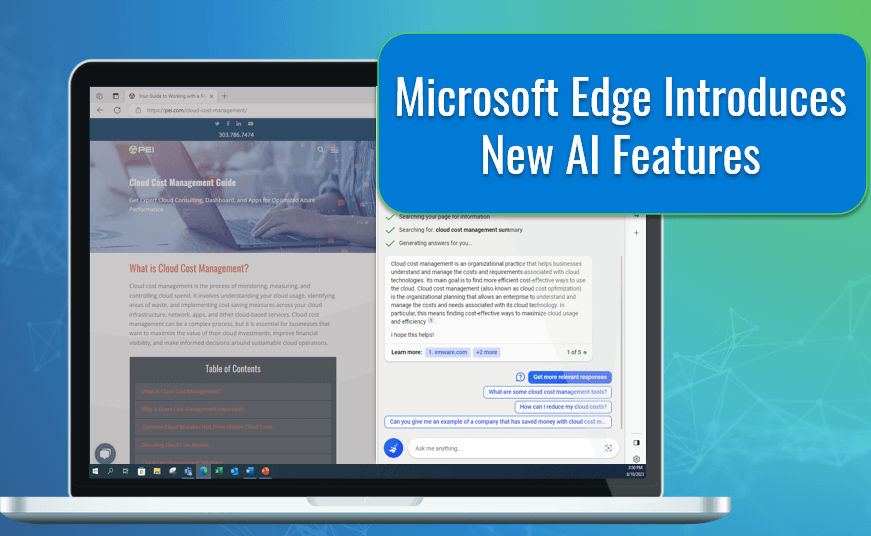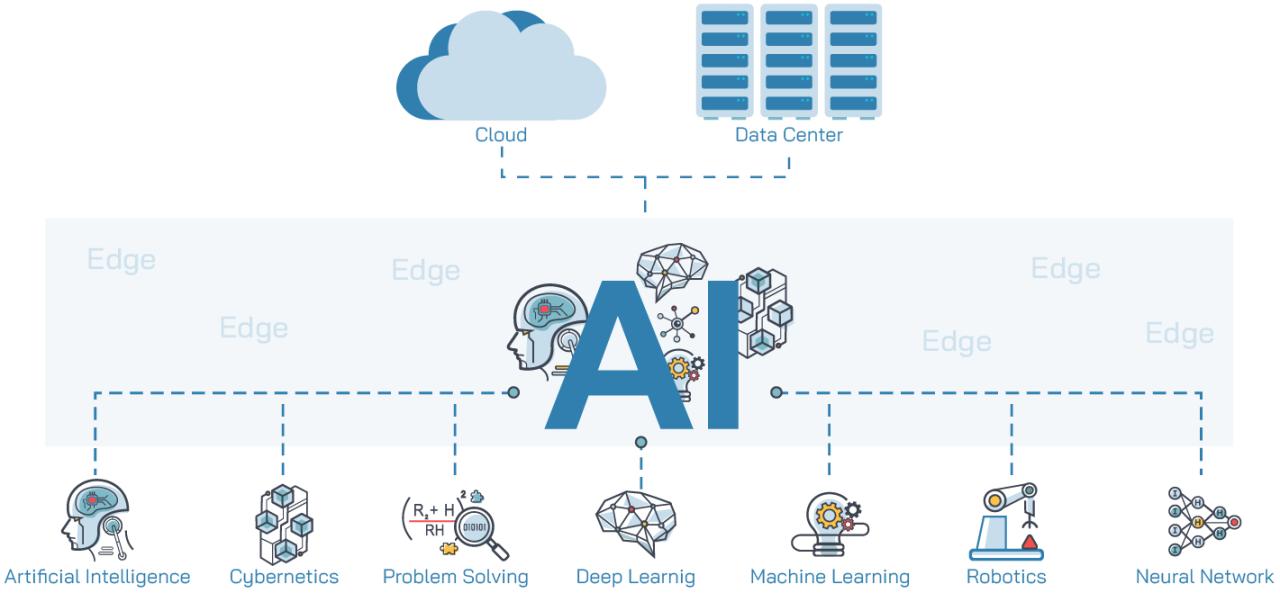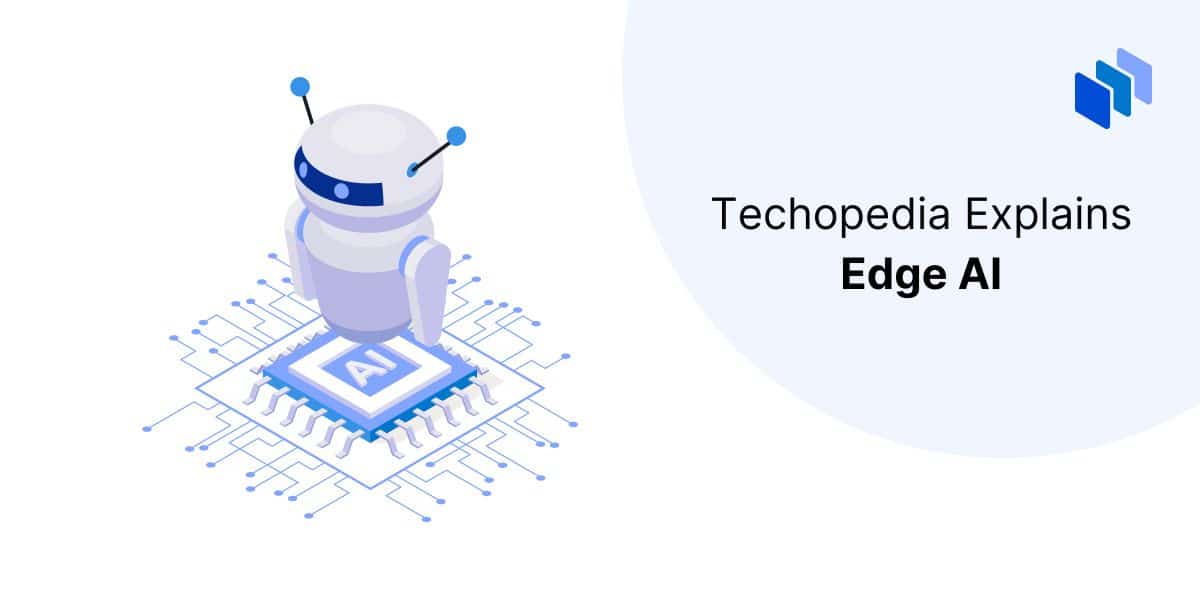Edge AI tools are revolutionizing how we process data, bringing the power of artificial intelligence closer to the source. This shift towards decentralized processing offers significant advantages in speed, efficiency, and data privacy, impacting various sectors from healthcare to manufacturing. We’ll explore the functionalities, applications, and future implications of these transformative technologies.
This exploration delves into the core components of Edge AI tools, examining their architecture and the diverse hardware and software platforms supporting their deployment. We’ll also address critical considerations surrounding data management, security, and ethical implications, providing a balanced perspective on the opportunities and challenges presented by this rapidly evolving field.
Defining Edge AI Tools

Edge AI tools represent a significant advancement in artificial intelligence, bringing the power of machine learning closer to the data source. Unlike cloud-based AI, which relies on sending data to remote servers for processing, Edge AI performs computations locally on devices like smartphones, IoT sensors, and embedded systems. This proximity offers several key advantages, including reduced latency, enhanced privacy, and improved reliability in offline or low-bandwidth environments.
Edge AI tools encompass a range of software and hardware components designed to enable on-device AI inference and, in some cases, training. Their core functionality revolves around processing data locally to generate real-time insights and predictions without the need for constant connectivity to a central server. The differentiating characteristic lies in this localized processing, enabling faster responses and reduced reliance on network infrastructure.
Types of Edge AI Tools
Edge AI tools are diverse and can be categorized based on their application and capabilities. This classification helps in understanding the breadth of their use cases and the specific functionalities they provide. The categories are not mutually exclusive, and some tools may fall under multiple classifications.
- Inference Engines: These are the core components that execute pre-trained AI models on edge devices. Examples include TensorFlow Lite, PyTorch Mobile, and OpenVINO. These engines optimize models for efficient execution on resource-constrained hardware, minimizing latency and maximizing performance.
- AI Development Platforms: These platforms provide comprehensive tools for building, deploying, and managing Edge AI applications. They often include model optimization tools, deployment frameworks, and monitoring capabilities. Examples include platforms offered by Google, AWS, and Microsoft, which provide integrated services for the entire Edge AI lifecycle.
- Hardware Accelerators: These specialized hardware components, such as GPUs, FPGAs, and specialized AI chips, significantly accelerate AI computations on edge devices. They are crucial for enabling real-time inference on devices with limited processing power. For example, many smartphones now include dedicated AI processors for faster image recognition and other tasks.
- Edge AI SDKs and Libraries: Software development kits (SDKs) and libraries provide pre-built functions and tools to simplify the development of Edge AI applications. They often include optimized algorithms, pre-trained models, and APIs for integrating AI capabilities into existing systems. These SDKs cater to various programming languages and hardware platforms, simplifying the integration process for developers.
Key Components and Architecture of an Edge AI Tool, Edge AI tools
A typical Edge AI tool comprises several key components working in concert. Understanding this architecture is vital for designing and deploying effective Edge AI solutions.
The architecture typically involves:
- Data Acquisition: This stage involves collecting data from various sensors and devices. This could include images from cameras, sensor readings from IoT devices, or audio data from microphones.
- Preprocessing: Raw data is often preprocessed to improve the accuracy and efficiency of the AI model. This might include cleaning, normalization, and feature extraction.
- Inference Engine: The core of the system, the inference engine executes the pre-trained AI model on the edge device to generate predictions or classifications.
- Post-processing: The output from the inference engine is often post-processed to make it more usable or understandable. This could include formatting the output, filtering results, or integrating it with other systems.
- Action/Output: Finally, the processed results trigger an action or provide output to the user or another system. This could be anything from controlling a robot arm to displaying a notification on a smartphone.
The efficiency and effectiveness of an Edge AI tool are largely determined by the interplay of these components and the optimization strategies employed throughout the entire process.
Applications of Edge AI Tools
Edge AI tools are rapidly transforming various sectors by bringing the power of artificial intelligence closer to the data source. This proximity allows for real-time processing, reduced latency, and enhanced efficiency, leading to significant improvements across diverse applications. This section will explore several key sectors where Edge AI is making a substantial impact, highlighting both the advantages and challenges encountered.
Edge AI’s deployment across different industries presents unique benefits and obstacles depending on the specific application and the environment. Factors such as data volume, network connectivity, and regulatory compliance play significant roles in determining the feasibility and success of implementation.
Edge AI in Healthcare
The healthcare sector is leveraging Edge AI for applications such as real-time medical image analysis, enabling faster diagnosis and improved patient care. For example, portable ultrasound devices incorporating Edge AI can provide immediate image interpretation at the point of care, eliminating the need for transferring data to a central server. This allows for quicker diagnosis of critical conditions, such as internal bleeding or organ damage, particularly beneficial in emergency situations or remote areas with limited connectivity. Another example is wearable health monitors using Edge AI to detect irregular heart rhythms or falls, providing immediate alerts to caregivers or emergency services.
Edge AI in Manufacturing
In manufacturing, Edge AI is enhancing predictive maintenance, improving quality control, and optimizing production processes. Smart sensors embedded in machinery collect real-time data on equipment performance, and Edge AI algorithms analyze this data to predict potential failures before they occur. This proactive approach minimizes downtime, reduces maintenance costs, and prevents costly production disruptions. Furthermore, Edge AI-powered vision systems can identify defects in products on the assembly line with high accuracy, ensuring consistent product quality and reducing waste. An example would be an AI-powered system inspecting circuit boards for faulty components, providing immediate feedback to adjust the production line accordingly.
Edge AI in Transportation
The transportation industry utilizes Edge AI for applications such as autonomous driving, advanced driver-assistance systems (ADAS), and traffic optimization. Self-driving cars rely heavily on Edge AI for processing sensor data (camera, lidar, radar) in real-time to navigate roads and avoid obstacles. ADAS features like lane departure warnings and automatic emergency braking also depend on Edge AI’s ability to quickly process visual and sensor data. Smart traffic management systems using Edge AI can analyze traffic patterns and optimize traffic flow in real-time, reducing congestion and improving travel times. For example, adjusting traffic light timings based on real-time traffic density data.
| Application | Tool/Example | Benefits | Challenges |
|---|---|---|---|
| Medical Image Analysis | Portable AI-powered ultrasound | Faster diagnosis, improved patient care, reduced reliance on central servers | Data privacy concerns, algorithm accuracy, regulatory compliance |
| Predictive Maintenance (Manufacturing) | AI-powered sensor network on industrial machinery | Reduced downtime, lower maintenance costs, improved production efficiency | High initial investment, data integration complexity, algorithm training and maintenance |
| Autonomous Driving | AI-powered perception system in self-driving cars | Improved safety, increased efficiency, reduced traffic congestion | Computational resource constraints, data security, ethical considerations |
| Traffic Optimization | AI-powered traffic management system | Reduced congestion, improved travel times, optimized resource allocation | Data acquisition and processing, infrastructure requirements, algorithm robustness |
Hardware and Software Considerations

Deploying Edge AI tools requires careful consideration of both hardware and software components. The performance, efficiency, and overall success of an Edge AI application are directly tied to the capabilities of the underlying hardware and the effectiveness of the chosen software framework. Balancing computational power, memory capacity, power consumption, and development ease is crucial for optimal results.
Successful Edge AI deployment hinges on selecting hardware and software that are well-matched to the specific application’s needs and constraints. A resource-intensive application like real-time video analysis would demand significantly more powerful hardware than a simpler task such as anomaly detection in sensor data. Similarly, the choice of software framework will impact development time, deployment complexity, and the overall maintainability of the solution.
Hardware Requirements for Edge AI
Edge AI devices need sufficient processing power, memory, and energy efficiency to execute AI models effectively. Processing power is critical for handling computationally intensive tasks like inference and model training (if done on the edge). Memory is needed to store the AI model, input data, and intermediate results. Power consumption is a key factor, particularly for battery-powered devices, limiting the complexity of models and the duration of operation. For example, a low-power microcontroller might be suitable for simple classification tasks, while a high-performance GPU is necessary for complex image recognition applications. The selection process should always start with a clear understanding of the computational requirements of the chosen AI model.
Software Platforms and Frameworks for Edge AI
Several software platforms and frameworks are available for developing and deploying Edge AI tools. Each offers a unique set of features, strengths, and weaknesses. Popular choices include TensorFlow Lite, PyTorch Mobile, and OpenVINO. TensorFlow Lite is known for its lightweight nature and optimized performance on mobile and embedded devices. PyTorch Mobile offers a similar advantage, particularly useful for applications requiring dynamic computation graphs. OpenVINO provides a comprehensive toolkit for optimizing and deploying deep learning models across various Intel hardware platforms. The choice of framework often depends on factors such as developer familiarity, model compatibility, and the target hardware platform. Consideration should also be given to the availability of community support and documentation for the chosen framework.
Comparison of Hardware Platforms for Edge AI
The following table compares different hardware platforms commonly used for Edge AI deployment. Note that the specifications can vary widely depending on the specific model and configuration. These values are representative examples and should not be taken as absolute.
| Platform | Processing Power (Representative Example) | Memory (Representative Example) | Power Consumption (Representative Example) |
|---|---|---|---|
| Raspberry Pi 4 | Quad-core Cortex-A72 @ 1.5GHz | 4GB RAM | ~10W |
| NVIDIA Jetson Nano | Quad-core ARM A57 @ 1.43GHz | 4GB RAM | ~5W |
| Intel Neural Compute Stick 2 | Myriad X VPU | 16GB flash | ~3W |
| Google Coral Dev Board | Edge TPU | 4GB RAM | ~6W |
Security and Ethical Considerations: Edge AI Tools
The deployment of Edge AI tools introduces unique security and ethical challenges that require careful consideration. The decentralized nature of edge computing, coupled with the increasing sophistication of AI algorithms, creates vulnerabilities that need proactive mitigation strategies. Furthermore, the inherent biases within datasets and the potential for unintended consequences necessitate a robust ethical framework guiding the development and deployment of these technologies.
Potential Security Vulnerabilities and Mitigation Strategies
Edge AI devices, often operating in resource-constrained environments, are susceptible to various attacks. These range from unauthorized access and data breaches to manipulation of the AI models themselves, leading to inaccurate or malicious outputs. Effective mitigation requires a multi-layered approach.
- Hardware Security: Secure boot mechanisms, tamper-resistant hardware, and encryption of sensitive data stored on the device are crucial. This prevents unauthorized modification of the firmware and protects against physical attacks.
- Software Security: Regular software updates, robust authentication protocols, and secure coding practices minimize vulnerabilities exploitable through software flaws. Implementing sandboxing techniques can isolate AI models and protect against malicious code.
- Network Security: Secure communication channels between edge devices and the cloud, using VPNs and encryption, are essential to prevent eavesdropping and data manipulation. Regular security audits and penetration testing help identify and address weaknesses.
- Model Security: Protecting AI models from adversarial attacks, where inputs are deliberately manipulated to cause misclassification, is vital. Techniques such as adversarial training and input validation can enhance robustness.
Ethical Implications: Bias and Fairness
The datasets used to train Edge AI models often reflect existing societal biases, leading to unfair or discriminatory outcomes. For example, a facial recognition system trained primarily on images of one demographic may perform poorly on others, leading to potential misidentification and unjust consequences. Addressing this requires careful curation of datasets to ensure representation of diverse groups and the development of algorithms that mitigate bias.
Responsible AI Development and Deployment
Responsible AI development and deployment in the context of Edge AI necessitates a holistic approach encompassing data governance, algorithmic transparency, accountability, and ongoing monitoring. This involves:
- Data Privacy: Implementing robust data anonymization and encryption techniques to protect user privacy and comply with relevant regulations such as GDPR.
- Algorithmic Transparency: Making the decision-making processes of AI models understandable and explainable, allowing for scrutiny and identification of potential biases.
- Accountability: Establishing clear lines of responsibility for the outcomes of Edge AI systems, ensuring that developers and deployers are accountable for their actions.
- Continuous Monitoring: Regularly evaluating the performance and impact of Edge AI systems to identify and address unintended consequences or biases that may emerge over time.
Case Studies of Successful Implementations

Edge AI’s transformative potential is best illustrated through real-world applications. The following case studies showcase successful deployments across diverse industries, highlighting the tangible benefits of deploying AI processing at the edge. These examples demonstrate how Edge AI tools have improved efficiency, reduced costs, and enhanced decision-making capabilities.
Manufacturing: Predictive Maintenance in a Smart Factory
This case study focuses on a large manufacturing facility that implemented an edge AI system for predictive maintenance of its robotic assembly lines. The system utilized cameras and sensors deployed on the robots to collect data on their performance in real-time. This data was processed locally by an edge device equipped with a machine learning model trained to identify anomalies indicative of impending failures. The tool used was a combination of NVIDIA Jetson hardware and custom-built software utilizing TensorFlow. The results were a significant reduction in unplanned downtime (by 30%), a decrease in maintenance costs (by 15%), and an overall increase in production efficiency. Challenges included integrating the edge AI system with the existing factory infrastructure and ensuring data security.
Retail: Improved Customer Experience Through Real-time Analytics
A major retail chain implemented an edge AI solution to improve customer experience and optimize store operations. The system used computer vision technology deployed on edge devices located within the stores. These devices analyzed video feeds from security cameras to track customer traffic patterns, identify popular product displays, and detect potential security threats. The data analysis, performed locally, provided real-time insights allowing for dynamic adjustments in staffing levels, product placement, and security protocols. The tools employed were Intel OpenVINO toolkit and custom-developed algorithms. The implementation resulted in a 10% increase in sales conversion rates, a 5% reduction in theft, and improved customer satisfaction scores. A primary challenge was managing the large volume of data generated by the cameras and ensuring privacy compliance.
Healthcare: Faster Diagnosis with Mobile Edge AI
A telemedicine provider implemented an edge AI solution to enable faster and more accurate diagnosis of skin conditions. A mobile application, coupled with a smartphone camera, captured images of skin lesions. These images were processed using an edge AI model running on the smartphone itself, providing a near-instantaneous diagnosis. The model was trained on a large dataset of dermatological images. The tool utilized was a combination of TensorFlow Lite and a custom-built mobile application. This implementation drastically reduced diagnosis time, improving patient care and access to specialized medical expertise, particularly in remote areas. The key challenge was ensuring the accuracy and reliability of the model in diverse lighting and image quality conditions.
| Industry | Application | Tool | Results |
|---|---|---|---|
| Manufacturing | Predictive Maintenance | NVIDIA Jetson, TensorFlow | 30% reduction in unplanned downtime, 15% decrease in maintenance costs |
| Retail | Real-time Customer Analytics | Intel OpenVINO, Custom Algorithms | 10% increase in sales conversion, 5% reduction in theft |
| Healthcare | Faster Diagnosis (Skin Conditions) | TensorFlow Lite, Custom Mobile App | Drastically reduced diagnosis time, improved patient care |
The integration of Edge AI tools promises a future where real-time insights and intelligent automation are seamlessly embedded within everyday systems. By addressing the inherent security and ethical considerations, and leveraging advancements in hardware and software, we can unlock the full potential of Edge AI, driving innovation across diverse industries and creating more efficient, responsive, and intelligent solutions.
Edge AI tools process data locally, offering faster response times and reduced latency compared to cloud-based solutions. However, understanding the limitations of local processing is crucial; this often involves considering the benefits of offloading more complex tasks to the cloud, which is precisely why understanding What is cloud computing is vital. Ultimately, the optimal approach often involves a hybrid model, combining the strengths of both Edge AI and cloud computing for a more robust and efficient system.
Edge AI tools are revolutionizing data processing by bringing intelligence closer to the data source. This minimizes latency and bandwidth needs, but effective use requires insightful data analysis. Understanding the processed data is crucial, and this is where techniques like those described in this helpful article on Data visualization with AI become invaluable. Ultimately, effective data visualization enhances the overall efficiency and understanding of Edge AI deployments.
